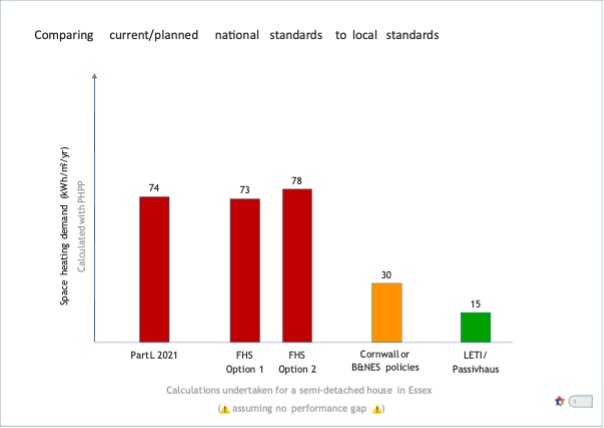Closing the energy performance gap to deliver true net zero buildings – curated by Building Performance Network – Tuesday 5th March, 13:15 – 14:00 (45 minutes), Energy stage
Summary by Elfed Lewis, Building Performance Network
The first seminar, “Closing the energy performance gap”, was chaired by our BPE Network Lead Elfed Lewis and delved into tackling the disparity between expected and actual energy efficiency in buildings, featuring experts Julie Godefroy, Luke Smith and Christian Dimbleby. Julie, Head of Net Zero Policy at CIBSE, introduced us to the BPE techniques used during “Retrofit Revisited”, and some of the results obtained from re-testing a set of properties, 10 years after they were upgraded. Luke Smith, Managing Director at Build Test Solutions discussed some of the technology his team have developed for testing different aspects of building performance. And finally, Christian Dimbleby, an architect and Chartered Engineer at Architype explained how their architecture practice have integrated BPE techniques into their entire build process – testing buildings after completion to ensure performance, and incorporating the results back into their pipeline to improve future building projects.
Energy efficiency standards: Are we going far enough? – curated by Good Homes Alliance – Wednesday 6th March, 11:30 – 12:15 (45 minutes), Buildings stage
Summary by Sophie Hockley, Good Homes Alliance
The building fabric options proposed in the recent Future Homes and Buildings Standards consultation are even less ambitious than those consulted on previously. On top of that, a Written Ministerial Statement (WMS) in December 2023 announced that “the Government does not expect plan-makers to set local energy efficiency standards for buildings that go beyond current or planned buildings regulations”.
For this session, GHA Chair Lynne Sullivan OBE was joined by Hugh Ellis (TCPA), Lewis Knight (Bioregional), and Thomas Lefevre (Etude) to consider if the Future Homes Standards proposals are really ‘fit for the future’, and the implications of the WMS for councils seeking to meet their climate emergency commitments.
Some key points from the presentations and discussion:
- Hugh Ellis highlighted planning’s extraordinary potential for mitigation and adaptation, particularly in relation to the effects of sea level on our coastal communities. National government is failing in its duty to move towards net zero, so the impetus for change currently lies with local authority.
- Consent is being granted for 300,000 houses every year, but 220,000 are being built – the failure is in planning the delivery of these consents. At the same time, the houses being built are too often of the wrong quality, in the wrong place, and at the wrong price.
- Lewis Knight noted that the Future Homes Standards (FHS) consultation relies on grid decarbonization, but it’s not clear if or when this will happen. The standards are not compatible with achieving NZ in operation or the 2050 national targets. Equally, they do not focus on occupant costs, the performance gap, energy use intensity or embodied carbon.
- There are two policy approaches for local authorities: NZ under building regs (successful plans include the GLA, Reading and Milton Keynes), or a more ambitious, measurable and effective NZ under EUI-based approach (successful plans include Bath & North East Somerset, Central Lincolnshire and Cornwall.)
- Thomas Lefevre provided a compelling argument for going further than the current (Part L 2021) and planned (FHS option 1 or 2) national standards, comparing these with local standards required by Cornwall and Bath & NE Somerset:

- The argument being made in the FHS is that further improvements will have a proportionally smaller effect on actual energy use. Yet this fails to account for the fact that simple improvements in airtightness and ventilation would have a significant impact on energy bills (-£330/year for a semi-detached house in Essex built to Cornwall or Bath & NE Somerset standards or -£370 if built to LETI/Passivhaus standards) and would result in better construction and indoor air quality.
- If the rationale behind the FHS and the WMS is to create a consistent national framework, then let’s work together to create one that is more effective, and delivers the standards that we need to meet for people and planet. For this, we also need to talk about metrics.
Find out more about our response to the Future Homes Standard consultation here – https://goodhomes.org.uk/news/industry-leaders-unite-consortium-issues-urgent-call-for-more-ambitious-future-homes-standard.
